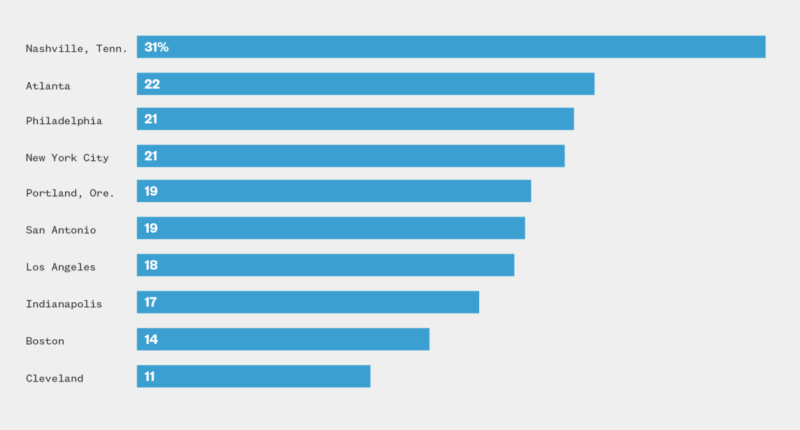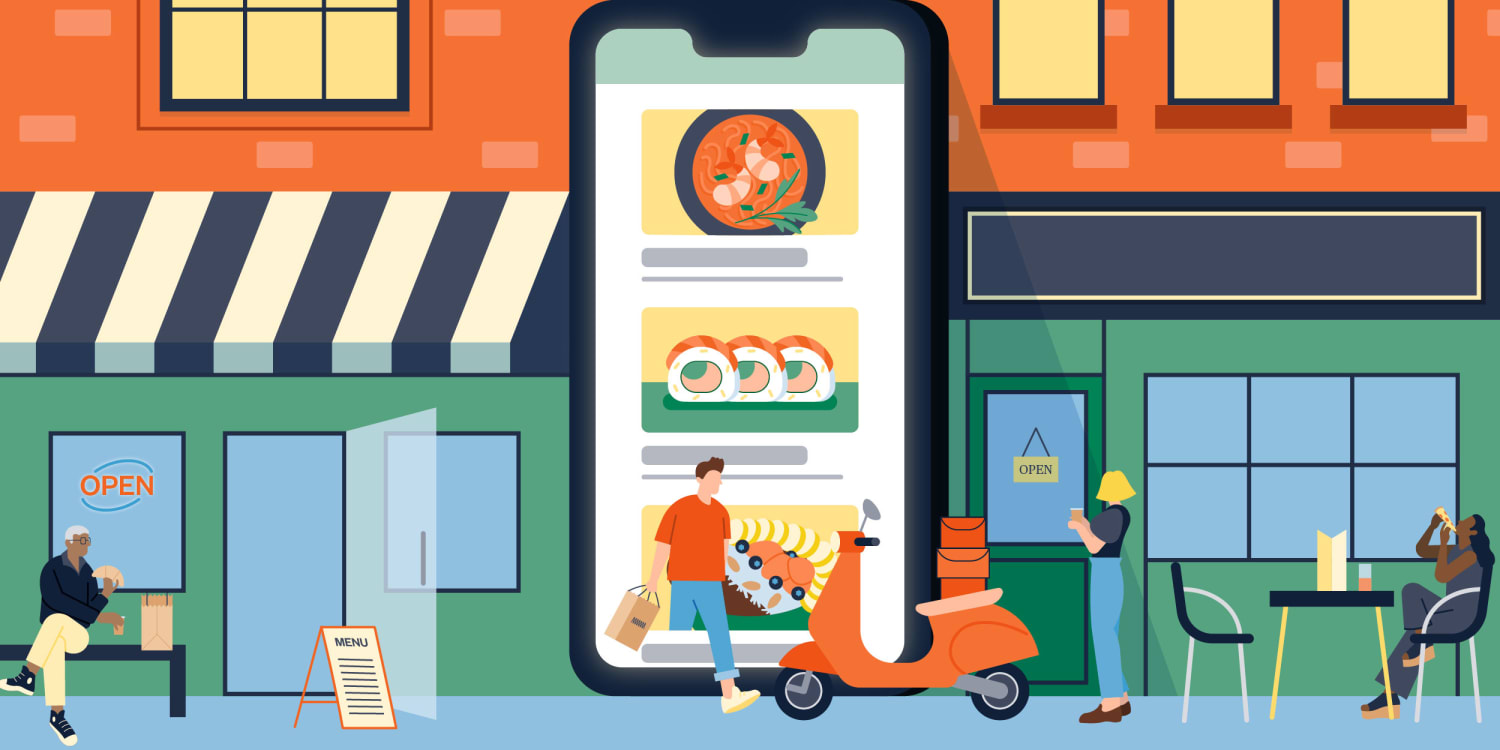
While these online listings drive business revenue through exposure and often bring in new customers, experts warn that unoriginal listings can crowd the dining landscape.
The prevalence of virtual restaurants varied among the cities analyzed, ranging from 1 in every 10 in Cleveland to nearly 1 in every 3 restaurants in Nashville, Tennessee.
This data comes from a sample of restaurant listings on Uber Eats’ platform, drawing from listings shown under each of the platform’s cuisine categories — fast food, ice cream, barbecue — for a given city.
Uber declined to comment when asked if the numbers in NBC News’ analysis align with Uber’s internal metrics.
According to one restaurant owner, the motivation for opening virtual restaurants whittles down to economics.
Rich, the owner of Spinners Pizza on Bleecker Street in Manhattan, operates more than 60 virtual brands across Uber Eats, DoorDash, Grubhub, Menufy, Seamless, Slice and Too Good To Go. Rich asked that his last name not be published, citing threats from customers and competitors about his virtual kitchens, and said that the multiple listings are what keeps his business afloat.
“It’s supposed to be the best street in the world for pizza,” Rich said. But that’s only on Friday and Saturday nights, and, he said, “the rest of the week isn’t enough to support the rent, the workers, the electric.”
During a reporter’s visit on a Thursday night in March, fewer than five customers set foot inside of Spinners.
As a restaurant owner, Rich is part of an industry with 5% profit margins and where nearly 9 in 10 operators say they are less profitable than they were pre-pandemic, according to the National Restaurant Association.
For restaurants, how visible these online listings are can lead to a 5% increase in revenue, said Abhishek Nagaraj, an associate professor in the Haas Business Schoolbusiness at the University of California, Berkeley, who specializes in the digital economy.
Rich’s virtual brands operate under names such as Paulie’s Pizza and New York Thin Crust Pizza. These eateries only exist on the internet and the majority, like Spinners, serve pizza.
While these additional listings can bring in new customers, Nagaraj said that restaurateurs with dozens of listings can also take customers from other businesses. Rich said one of his virtual brands has a name that’s very similar to a nearby brick-and-mortar competitor, which has prompted angry calls from confused customers.
Virtual restaurants are a boon to businesses that are “struggling in some kind of way,” said David Henkes, a senior consultant at Technomic, a business-focused market research company that specializes in the food service industry. Customers of delivery platforms tend to prioritize cost and speed, both of which are easier to provide than a one-of-a-kind in-person experience.
Virtual brand identities are easier to shape, which provides advantages, Henkes said.
Rich found that people were ordering from his virtual restaurants based on name alone. “You know, I want pepperoni pizza,” he said. “Wow, Pepperoniville, they must specialize in pepperoni. Let’s do that.”
“If they like the name, they order.”
Snappy names and convenience helped convince Ryan Benson, a marketer who lives in Los Angeles’ Sherman Oaks neighborhood, to order from The Meltdown.
“It was called the Giddy Up Melt and had things like burnt brisket tips; it sounded like a premium hipster joint,” Benson, 25, said. “I thought it was a hole-in-the-wall diner or a food truck that was selling on an app. I was not envisioning a Denny’s.”
In fact, the sandwich so enamored Benson that he only discovered the restaurant’s true identity after he made plans to eat there in person. While putting together a Yelp list of his favorite restaurants, Benson couldn’t find The Meltdown, so he searched the address from the app and was startled to see Denny’s listed there.
“I feel like I got catfished by my sandwich — everything I knew was a lie,” Benson said.
“[Virtual restaurants are] stealing attention from what I thought was a new or locally owned business,” Benson added. “It’s almost like they’re masquerading as a new small business — is this ethical?”
When asked for comment, a Denny’s spokesperson said the company “prioritized transparency” and disclosed its connection with The Meltdown on the virtual resturant’s “About Us” page. The spokesperson also noted, however, that individual partners choose what to display on their page and can opt not to show the “hosted by Denny’s” messaging.
From Benson’s perspective, there are other issues with virtual restaurants: “Do they have their own kitchen ratings, health ratings?”
His concern is not unwarranted: An address on Hudson Street in Manhattan is associated with nine different virtual restaurants, including Baozilla NYC and Chopped Cheese Factory, but searches on the New York City Department of Health and Mental Hygiene’s website for all nine restaurants at that address returned zero results.
A call to the business revealed that its physical dine-in location is neither a Baozilla nor a Chopped Cheese, but instead a small deli selling packaged snacks and a variety of prepared foods. In early March, the New York City Department of Health and Mental Hygiene issued the deli inspection violations for “filth flies” as well as “conditions conducive to rodents, insects, or other pests.” A worker at the store didn’t answer repeated questions about health inspections.
Nagaraj suggested that these additional identities, while potentially offering positive paths to reinvention, might also offer a restaurant a way to avoid accountability. “If you kill a [virtual] restaurant and start a new one with a new name, what do identity and reputation mean?” Nagaraj said.
These questions are driving delivery platforms to think carefully about their engagement with virtual restaurants.
On DoorDash, virtual restaurants are labeled and customers can access details about the physical location of the kitchen. Virtual brands are required to maintain documentation of their compliance with local health and safety regulations. In December, DoorDash also rolled out brand quality guidelines for operators, which emphasize “high-quality, differentiated [menu] selection.”
Uber Eats announced new guidelines for virtual kitchens in late March, tightening requirements and offering restaurants help to improve their listings. These changes include the removal of virtual brands that offer identical or near-identical menu items and increasing the customer rating needed to exist on the platform.
“The space has been a wild Wild West,” said John Mullenholz, who heads the virtual kitchens program at Uber Eats. While Mullenholz acknowledged that Uber Eats has been supportive of virtual brands and will continue to be supportive, he characterized the new guidelines as a pivot “from quantity to quality.”
Those changes “could be a problem,” Rich said last week. As of Friday he had not heard from Uber Eats.
“That’d be detrimental,” Rich said. “If they did that, I’d definitely be out of business.
“It’s the only way I can compete.”
Source: | This article originally belongs to Nbcnews.com









